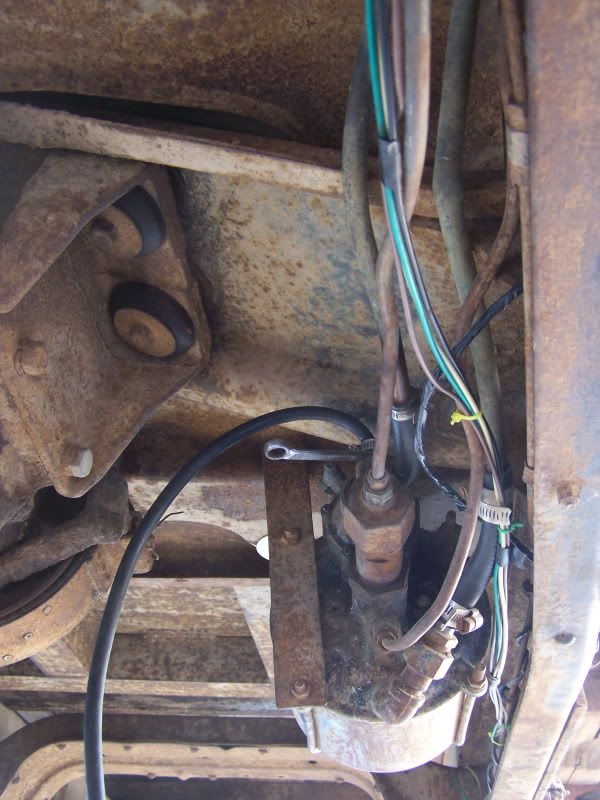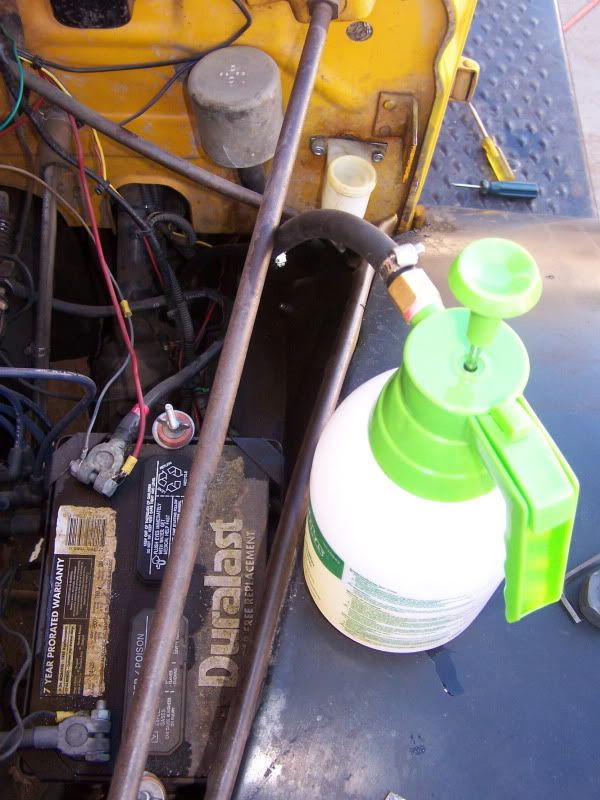Last weekend I took the '56 FFPW out for a drive and the brakes seemed a bit mushy. Usually the brakes work very well, with no pumping required, but this time they seemed a bit soft, but firmed up with a pump or two. I made it to Lowes with a pump or two on the brakes, but no big deal. On the way back, coming to a red light, I tapped the brakes and NOTHING...the pedal went all the way to the floor. Downshifted, and pumped the brakes and still nothing! Did some panic pumping and finally went for the nuclear option of reaching for the emergency brake. Fortunately this is well adjusted.......If I'd been a bit gentler with the e-brake I might have come to a gentle stop, but being in a panicky state of mind, I just yanked it back as hard as I could and it locked up the back tires resulting in a tire howling stop that nearly gave me and everyone else in the intersection a coronary!
So the good news is that I managed to make it home without crushing any Honda Civics, but the bad news is that I can't figure out what is wrong!
Here's the state of affairs as best I can figure them.
1) This is a 1956 FFPW with factory Hydro-Vac power assist.

2) The brake shoes in good shape, and are well adjusted
3) All new wheel cylinders, and none of them are leaking.
4) I removed the master cylinder and bench tested it, and it seemed to work under bench test conditions. I disassembled it, and it has either been rebuilt, or has been replaced in the past couple years. At least when bench testing, it seemed to build up pressure, and would hold it without any evidence of leaking past the piston.
5) I put the master cylinder back on the truck.
6) I have bled the brakes using the garden pressure sprayer method, including the bleed valve at the hydro-vac booster. (I have a remote reservoir hooked and and just tapped the garden sprayer into the line that goes from the reservoir to the master cylinder)


7) Brake fluid is completely clear with no rust evident anywhere.
After all this the brake pedal still drops to the floor. Here's the weird part...with the garden sprayer hooked up to the master cylinder and pressurized, the brakes work great. Take the pressure off the garden sprayer and they flat out don't work at all.
I'm stumped...but thinking that maybe the hydro vac is busted?
I've read that upgrading to a dual reservoir master cylinder is not a difficult job, but I don't know if the master cylinder listed there (NAPA, #4736308) would be compatible with my hydro vac assist.
http://mysite.verizon.net/kkull99/Fr...les_brakes.htm
Any help would be appreciated!
Mike
So the good news is that I managed to make it home without crushing any Honda Civics, but the bad news is that I can't figure out what is wrong!
Here's the state of affairs as best I can figure them.
1) This is a 1956 FFPW with factory Hydro-Vac power assist.

2) The brake shoes in good shape, and are well adjusted
3) All new wheel cylinders, and none of them are leaking.
4) I removed the master cylinder and bench tested it, and it seemed to work under bench test conditions. I disassembled it, and it has either been rebuilt, or has been replaced in the past couple years. At least when bench testing, it seemed to build up pressure, and would hold it without any evidence of leaking past the piston.
5) I put the master cylinder back on the truck.
6) I have bled the brakes using the garden pressure sprayer method, including the bleed valve at the hydro-vac booster. (I have a remote reservoir hooked and and just tapped the garden sprayer into the line that goes from the reservoir to the master cylinder)


7) Brake fluid is completely clear with no rust evident anywhere.
After all this the brake pedal still drops to the floor. Here's the weird part...with the garden sprayer hooked up to the master cylinder and pressurized, the brakes work great. Take the pressure off the garden sprayer and they flat out don't work at all.
I'm stumped...but thinking that maybe the hydro vac is busted?
I've read that upgrading to a dual reservoir master cylinder is not a difficult job, but I don't know if the master cylinder listed there (NAPA, #4736308) would be compatible with my hydro vac assist.
http://mysite.verizon.net/kkull99/Fr...les_brakes.htm
Any help would be appreciated!
Mike
Comment